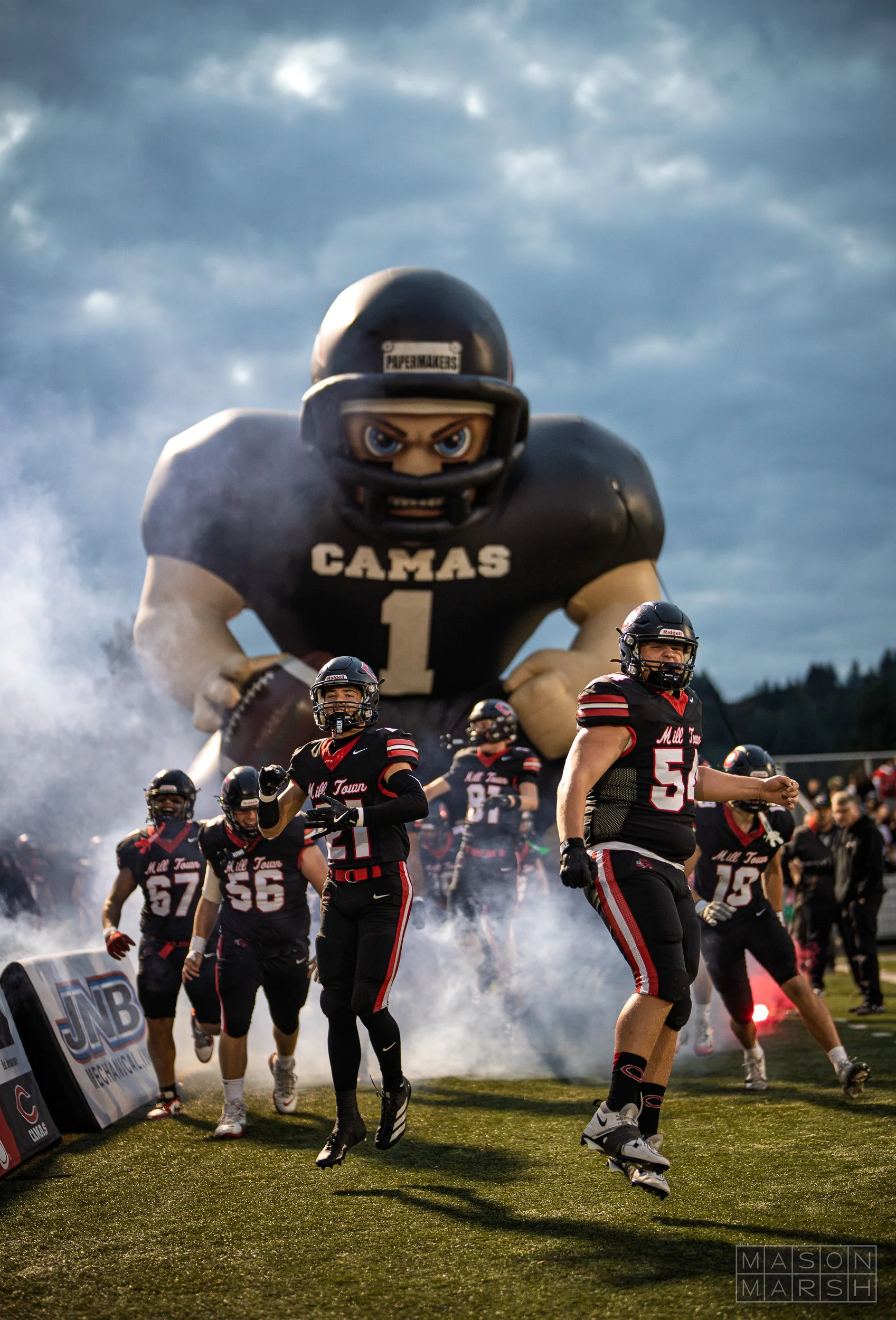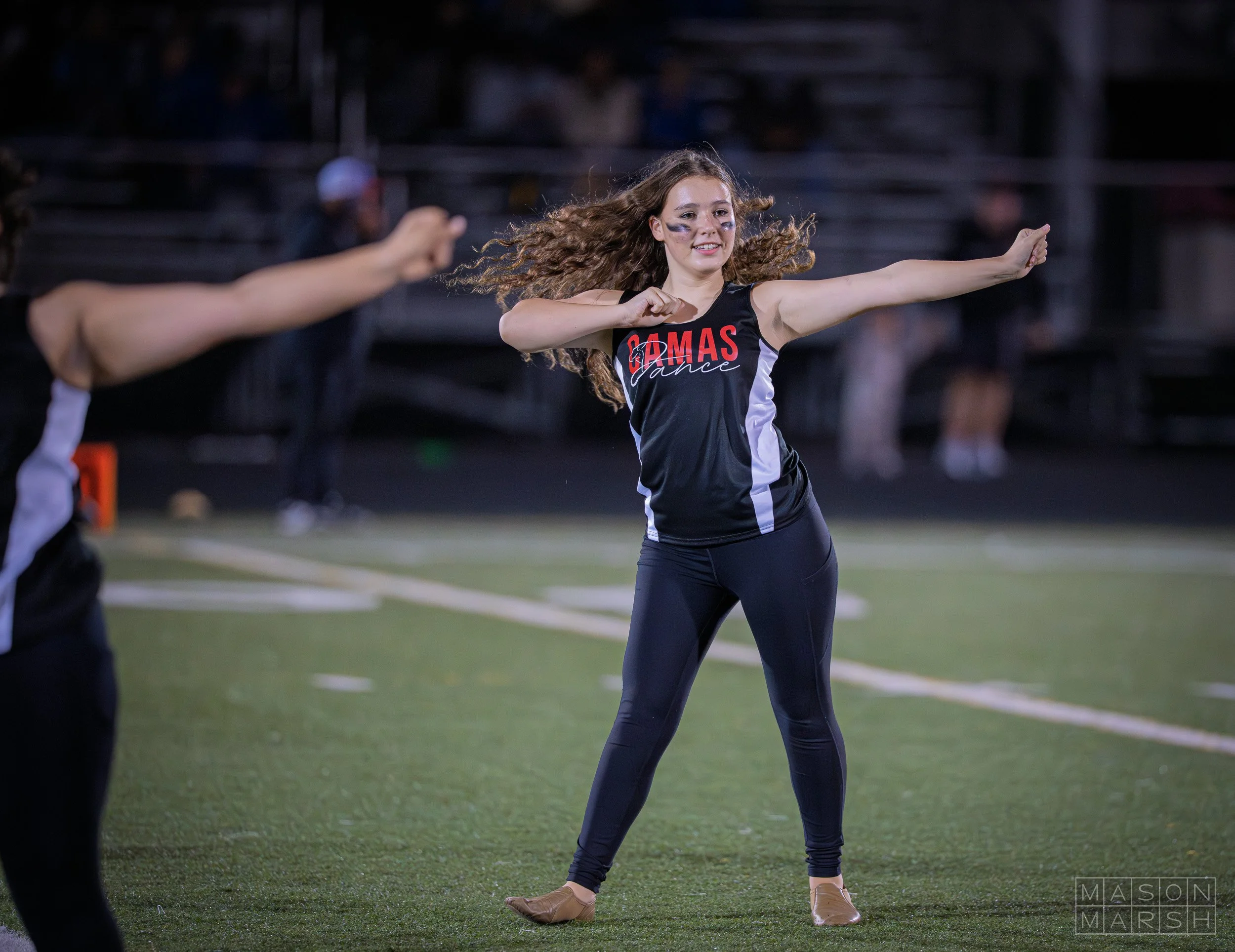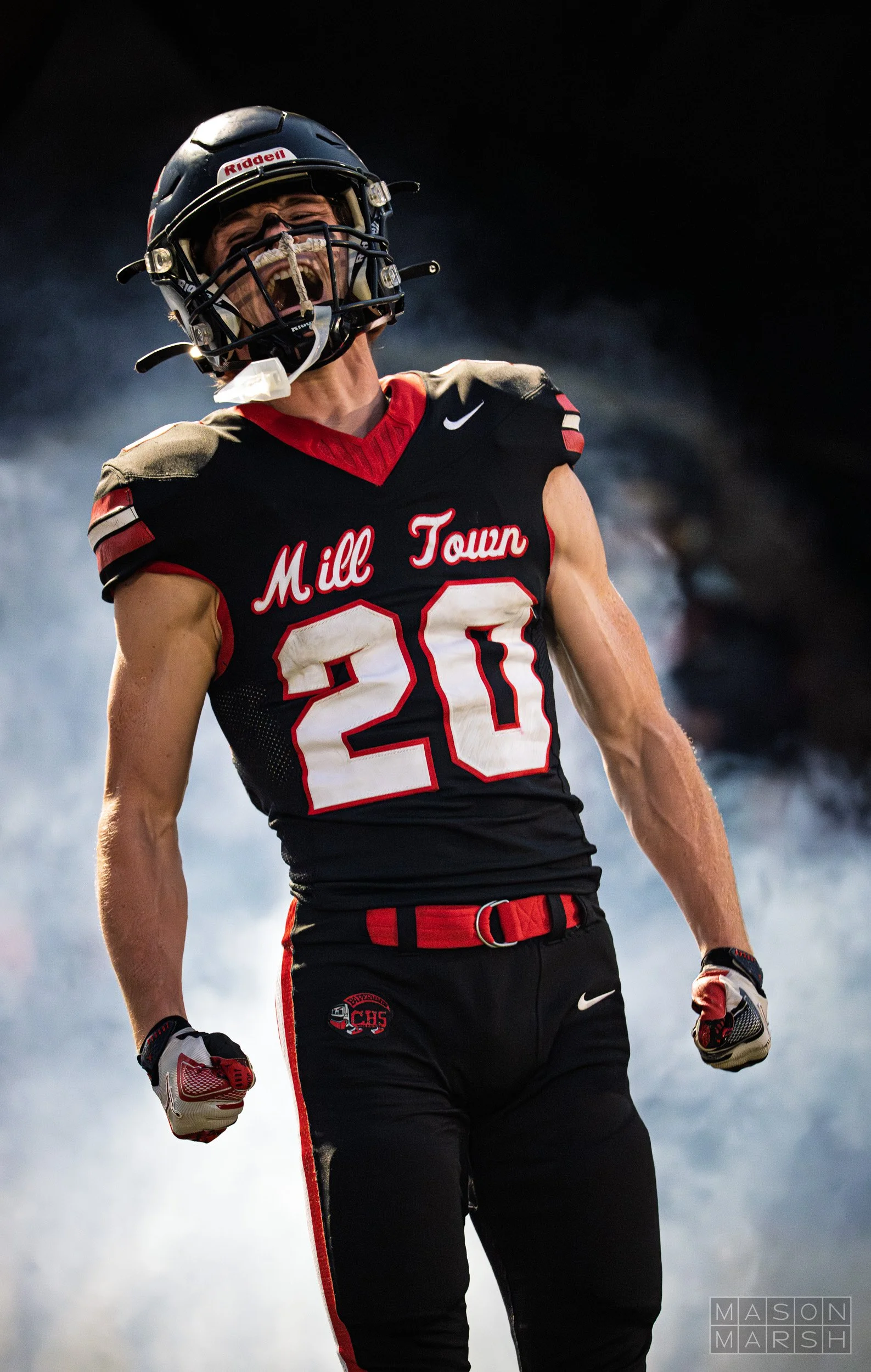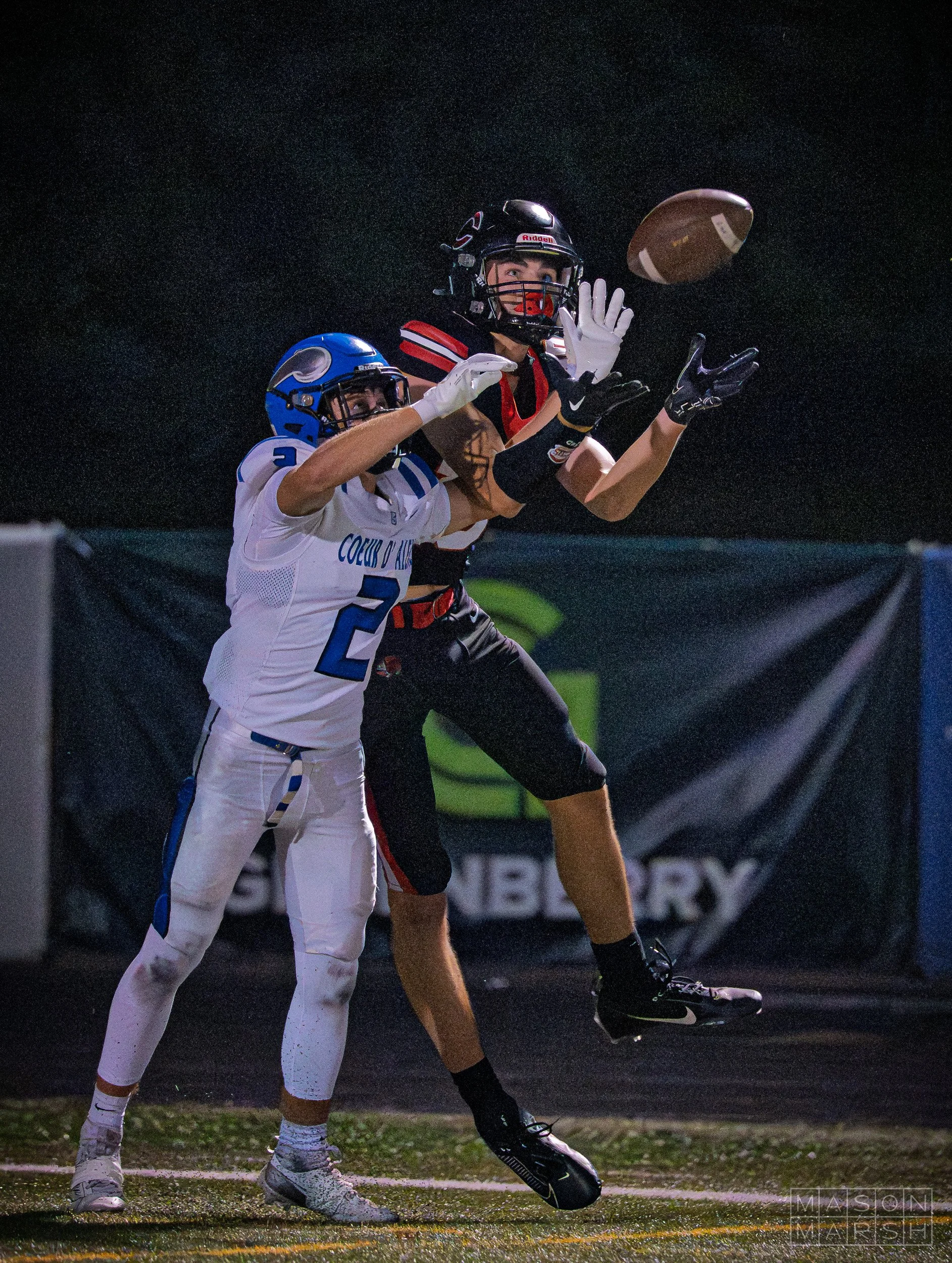What is it about football?
I didn’t grow up in a home where we gathered around the TV to watch football each weekend, but I do recall with clarity watching Jim Zorn toss the pigskin to Steve Largent to the thunderous cheers of a Kingdome crowd, so I obviously caught a game now and then. Growing up in the Northwest, we didn’t have powerful cultural connections with our local football teams. The Seahawks (Zorn and Largent among them) were fun to watch but never national contenders and my high school had a football team but I think they sucked pretty bad because I don’t recall them ever making the playoffs. As for college teams, in Spokane we had Gonzaga and Whitworth, one had no football program and the other was insignificant beyond the boundaries of the campus. All that is to say, football wasn’t a big deal for me as a kid.
Sure, I went to high school games and sat on the cold rain, but I honestly can’t remember much of it. I must have photographed a game or two, but the memories weren’t worth holding. In college, I went to games and photographed games, but they didn’t fire me up. It wasn’t until I graduated and began my career as a newspaper photojournalist that I learned how big football really is.
In Alaska, where I cut my teeth in newspapers, high school football was a spectacle. Each Saturday between August and late November was spent marching up and down muddy sidelines shooting the players who relentlessly punished each other with muscles honed pulling fishing nets and splitting firewood. These boys were rough and the games were thrilling. As many Alaskans in my town were from oil country, their allegiances to Texas football was enduring and the Cowboys and Oilers had many more fans than the more proximal Seahawks. Many of the biggest NFL players found their way to my area to fish in the summer months when world-record salmon made their run up the Kenai River. I photographed many of these hulking heroes and saw first-hand how much their fans adored them and their sport.
Later, in Oregon, I shot many more high school games. This time, on Friday nights under the lights with big crowds and local excitement even bigger than the Alaskans’. One of the two high school teams in our town was a favorite to win state and their program was massive. I dared not miss a game as they were the only thing happening. It was incredibly fun to cover and I loved the challenge of capturing it all.
Years after I left the newspaper industry I was working in Wisconsin at the height of the Brett Farve Green Bay Packers era and I got to see just how nuts people can get about football. Where I lived was an hour south of Green Bay, but still deep in the green and gold heart of Packer country. Not being a rabid football fan, I didn’t fully appreciate the passion of the fans there, but I sensed it was what many of them cared most about and the general vibe of the entire state seemed to rise and fall with the Packers’ wins and losses.
Fast forward to now and we’ve landed in a small town where football is big. Our local high school has a pretty good team and when they play at home the stadium fills with seemingly everyone in town. Camas, Washington is home to Camas High School and a partially-mothballed paper mill that towers over the town. The Papermakers (great mascot, IMHO) are a big school of about 2,000 kids, my son Cooper amongst them. I’ve been enjoying shooting sports for the past few years, mostly soccer, so the prospect of covering some football was something I wanted to explore. An old college friend is a teacher at the high school and I’ve spoken to his photography students so I reached out to see about getting field access. Brian was happy to have me help him support the school yearbook and newspaper photographers, so I showed up at the first home game ready to go.
I realized that I hadn’t shot a single down of football for 28 years, but it felt great to be back. The weather was perfect and the fans that packed the stadium were fired up. In the Papermakers’ first game of the season up in Seattle, the team stomped their opponents so confidence was high as they faced off against Mt. Tahoma High from Tacoma. It wasn’t long before reality set in that the massive Mt. Tahoma players came to win and Camas was shocked by several quick touchdowns.
For me, the drama of the game made for great images. I hate to see blowouts… I much prefer the stress of a close game. Camas fought back and scored a couple, but in the end Mt. Tahoma outscored them.
This post isn’t about the scores, or who won what… it’s about the photography. So let’s get to that.
At the first game I brought my two Sony Cameras. The A1 Mark II had my Sony 300mm F2.8 lens attached and the A7R Mark V worked with the Sony 70-200 F2.8 and Sony 50mm F1.2. The A1 II is a brilliant camera for sports and paired with the 300 it was so much fun. When I last shot football, I was using a Canon EOS-1 with the Canon 70-200 F2.8 shooting film. I bought that kit in 1992 and at the time it was state of the art autofocus and optics. 33 years is a very long time when it comes to tech and shooting two high resolution digital cameras at ISO 20,000 using the latest autofocus made easy work of the night game. I’m often in awe of how far we have come in photography. I used to strain my film to 1600 ISO which forced me to shoot at desperately low shutter speeds to get results. I would blow through roll after roll of film in the hope of getting a small handful of usable frames. The keepers were usually grainy, sad messes but if I nailed focus and had the ball in the shot I was happy. At the first Camas game, I shot almost 3,000 images and had hundreds of keepers. My younger self would have not believed it.
After the first game, I felt like I was re-acquainted with football shooting. I retained all of my sideline strategies from covered dozens, maybe hundreds of games back in the day and I now possessed much better technology and photographic skill. It felt great to bring a lifetime of experience to bear on a photographic challenge from my past and come away with images I’m proud of. Going in, I wasn’t sure I’d succeed.
After that first game I spent some time with the yearbook photographers talking about photography, specifically football photography. They are a wonderful group of kids who seem to appreciate what I have to offer, so with one game behind us and some of the basics covered, we met before the next home game and I gave them more tips and we tried it all again.
This time the Papermakers were hosting the Lincoln Abes, (how cool are these names?). I worked the game trying some different angles and autofocus settings. Thanks to the helmets football players wear, face-detect autofocus doesn’t work so settings that I rely on when shooting soccer or other fast-paced sports are useless. Football involves a lot of criss-crossing subjects and that also tricks the autofocus systems. I found myself using spot focus and some tracking to tease out the best results. Shooting with wide-open apertures is a must to keep the background soft, so precise autofocus is critical. I’m amazed at how well the A1 II did. For some of the plays I shot at 20 frames per second and the AF was able to keep up in most cases. Incredible. With my autofocus settings pretty well settled I worked to compose well. Keeping a fast-moving player in the frame is a tricky thing at 300mm and in a lot of my shots I had cut off feet and other issues.
At the top of my long mental wish list for shooting football, I’d love to gain eye contact with the athletes. In the Lincoln game I worked to position myself in the line of action in an attempt to capture images with a good connection with the subjects. So much of football is athletes looking down as they collide and drive forward, so I’m hunting for running backs looking for gaps, quarterbacks aiming down field and defensive backs looking for prey. In my newspaper days, constrained by the 200mm end of my longest bright lens, I’d avoid going to the end zones because the subjects would be too far away for all but the last 15 yards of the field. With the 300mm and enough pixels to crop, I can now lurk in the end zone and shoot the athletes face-on as they work for yardage. Photographers working college and pro games pretty much camp out in the end zones to stay out of the way of the throngs of personnel that teams deploy to the sidelines now. In high school games, I have some freedom to roam portions of the sidelines and the entire breadth of the end zones. It’s a luxury not lost on me, and it really helps get the eye contact images I’m looking for.
I’ve written here about the incredible performance my modern digital cameras provide in difficult light. Being able to take my ISO into the tens of thousands and still have usable images is nothing short of miraculous. For these night football games, I need to shoot at very high shutter speeds to freeze the athletes and have sharp results. That translates into shutter speeds well above 1/1,000 of a second. I aim for 1/2000 of a second and on most of the field I can get that at an ISO of 20,000. Of course, that’s with my F2.8 lens wide open. I shoot in manual mode and I’ve been guiding the student photographers I’m working with to do the same. In looking at their shots, they tend to all be underexposed, which is consistent with my results when I allow the camera to set the ISO. In coming weeks, we will be working on taking more control of exposure and managing the tough lighting of night games.
But the magic of high school football isn’t all on the field. As easy as it is to keep focused on the players, there are other athletes and performers to photograph. The cheerleaders, dancers and band members who work just as hard as the football players get to have their time in the spotlight at these games, making for a diverse and fun photographic spectacle. At halftime, I enjoyed capturing these other students showing off the things they have been working on for months. I find the halftime show to be a wonderful palate cleanser from the rough contact on the field.
I’ve shot three home Papermaker games now and I’m hooked. The technical challenges of shooting fast, cluttered action in low light is a great test of my skills and the vibrant, enthusiastic atmosphere is creatively inspiring. The added thrill of being able to mentor some young photographers as they learn their craft is truly rewarding.
So, I get it - this football thing. I like the competition and the risk, the spectacle and the emotion, the noise and the chaos. It’s a fine diversion from a long week of routine. I’ve always understood why people get so worked up about sports. It taps into our tribal brains and fills some of the longing we all have for conflict, all in the name of fun. I love traditions and cultural curiosities like painting faces, running through big banners and pounding drums. Football is a lot of things and working hard to capture the nuances of it all is a thrill.
I’m a long time removed from my high school experience, so far so that it seems like another life. I look at these kids playing this game, and all of the kids around them cheering, playing and dancing and it reminds me of when I was figuring things out and looking at the future with impatience. I haven’t forgotten the thrill of being with friends in the cold autumn air, yelling and being wild, all while trying to be as cool as possible. I see a lot of familiar things at these Friday night games, and it grounds me.
Football is a chance for all of us to celebrate the successes and failures that come with every down. We can live and die with each interception, sack, fumble and touchdown. Taken aside from the emotion of competition and all of that, it’s a really strange sight to see people in funny pants with their shoes taped on and their big floppy shoulder pads and scratched up helmets bashing into each other knowing full well that they are going to be really sore in the morning. Put all together, it all makes perfect sense. A bunch of kids trying to sneak a ball to the other end of the field while another bunch tries to kill them. Pretty much life.
We have several games left in the season, and I have no idea if the Papermakers will make the playoffs but I am really excited to see them try. I’m hooked on shooting this sport right now and I hope they go all the way to state so I have more and more chances to get great shots. The truth is, I’m finding that shooting sports is keeping me motivated to improve my craft, dial in my skills and try new things. Go Papermakers!






















